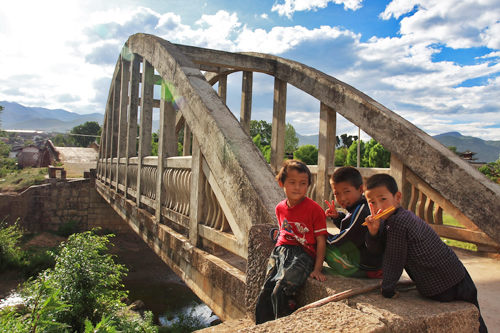|
 |
|
OVER THE RIVER: Children in Shaxi Town at Yujin Bridge, a centuries-old structure (CFP) |
Between two of the best known tourist destinations in southwest China's Yunnan Province, Lijiang and Dali, another ancient town has sat, largely overlooked, for much of the past century.
Shaxi, an extraordinarily well-preserved small town in Jianchuan County, houses treasures, tea houses and architecture that date back more than 1,400 years.
It has been called the only living link left along the Silk Road, an ancient trade route that connected China to West Asia for more than 1,400 years. Located several hours drive from the nearest major city, Shaxi remained extremely isolated until very recently and the town's people, 90 percent of whom are from the Bai ethnic group, therefore maintain a largely traditional way of life.
Despite its rich history and exceptional state of preservation, Shaxi was in fact virtually unknown to outsiders until 2001, when Jacques Feiner from the Swiss Federal Institute of Technology visited this area and realized the historical wealth of the little town.
"It was so original and so many buildings and sites from its trading days remained," Feiner said.
Shaxi flourished from 1368 to 1911, when it was a major commercial hub on the Silk Road. Nestled in a beautiful green valley with a pleasant climate, the road through Shaxi was the preferred route of caravaners trading in tea and horses.
Traders carrying different goods would meet in the town and exchange their wares at the town fair.
The main market area in the town, Sideng Market, has remained largely unchanged for centuries. In the past whenever trading caravans came to the town, they sold some of their goods for local produce in the evening. Around the market square were dozens of guesthouses, where traders would spend the night.
Nowadays, at night, the locals still gather in the market area to dance and play music and every Friday, the Bai people from all the villages in the Shaxi Valley and the Yi people from the surrounding mountains all come together to trade everything from fresh produce to supplies and horses. Minority women will be dressed in their colorful traditional costumes, and men will often lead pack mules to carry supplies back to their mountain villages, much like in the days of the Tea & Horse Caravan Trail hundreds of years ago.
On one side of the market square sits the Xingjiao Temple, parts of which date back to the early 1400s. It used to be a busy holy place filled with the sounds of chanting and prayers. Also in the square sits the old town's more prominent building, the Sideng Theater, where merchants once gathered to watch operas.
Courtyard homes and guesthouses make up much of the rest of Shaxi. Some of the guesthouses have been in operation for more than 100 years. Comprised of several courtyards, the Laomadian Lodge sits in a 151-year-old building, which was used as accommodation for Silk Road travelers. The guesthouse still houses many of the original cabinets that horsemen slept on top of to guard their personal belongings. White reflecting walls in the courtyards display restored Bai paintings, and, as with all of Shaxi, stepping across the threshold of the inn feels like stepping back through centuries in time.
After 1949, Shaxi fell into relative isolation. History largely forgot the town over the following decades, and even the early days of tourism in neighboring Dali, Lijiang and Shibaoshan left no trace on Shaxi. This gave Shaxi time to wait for a gentler re-awakening.
In 2001, the World Monument Fund added Shaxi's market square to its Watch List of 100 Most Endangered Sites as the only surviving example of a market town on China's old caravan roads. After that, a team of researchers from the Swiss Federal Institute of Technology and the local Jianchuan County Government launched a $1.3- million Shaxi Valley Rehabilitation Project. The project consists of five parts, marketplace restoration, village preservation, sustainable valley development, ecological sanitation and poverty alleviation.
| 